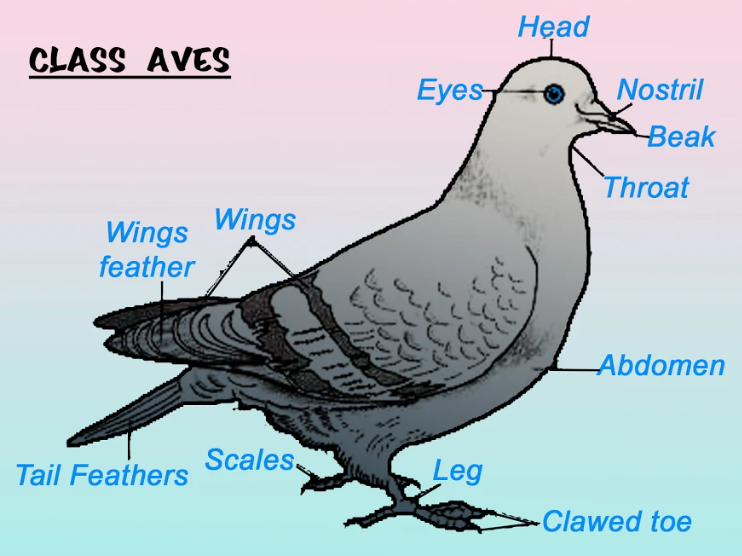
Answer
442.5k+ views
Hint: They belong to phylum Chordata of the animal kingdom. They are able to maintain constant body temperature and are called homoiothermous animals.
Complete answer:
Class Aves was from the superclass Tetrapoda (bears limbs), of division Gnathostomata (bears jaw) of division Vertebrata. There are about 9,000 species in this class. Aves are adapted to fly using their feathers. They are the most beautiful and visually stunning features such as bright and contrasting colors. Example: Columba (Pigeon), Pavo (Peacock).
Additional Information: The characteristic features of Aves are described below:-
-The most important features of aves were the presence of feathers. So, most of them can fly except flightless birds like Ostrich.
-They possess beak.
-It also has a sharp sight.
-It has a special organ called the syrinx for producing the voice.
-The forelimbs are modified into wings.
-The birds have 12 pairs of cranial nerves.
-For walking, swimming, or clasping to the tree branches, they have modified hind limbs with scales.
-Except for the oil gland at the base of the tail, Skin is completely dry without glands.
-Endoskeleton is fully bony and long bones are hollow with air cavities.
-The heart is completely four-chambered.
-They are homoiothermous animals.
-Respiration is by lungs. Air sacs connected to lungs supplement respiration.
-Sexes are separate.
-It also exhibits sexual dimorphism.
-Fertilization is internal.
-The eggs have four embryonic membranes, that are chorion, amnion, allantois, and yolk sac.
-They are oviparous and development is direct.
Note: Class Aves were classified into two categories. They are Archaeornithes and Neornithes. The birds in the Archaeornithes were extinct and had a toothed beak with a long lizard-like tail. The Neornithes include extant as well as extinct birds and they have no teeth and a short tail.

Complete answer:
Class Aves was from the superclass Tetrapoda (bears limbs), of division Gnathostomata (bears jaw) of division Vertebrata. There are about 9,000 species in this class. Aves are adapted to fly using their feathers. They are the most beautiful and visually stunning features such as bright and contrasting colors. Example: Columba (Pigeon), Pavo (Peacock).
Additional Information: The characteristic features of Aves are described below:-
-The most important features of aves were the presence of feathers. So, most of them can fly except flightless birds like Ostrich.
-They possess beak.
-It also has a sharp sight.
-It has a special organ called the syrinx for producing the voice.
-The forelimbs are modified into wings.
-The birds have 12 pairs of cranial nerves.
-For walking, swimming, or clasping to the tree branches, they have modified hind limbs with scales.
-Except for the oil gland at the base of the tail, Skin is completely dry without glands.
-Endoskeleton is fully bony and long bones are hollow with air cavities.
-The heart is completely four-chambered.
-They are homoiothermous animals.
-Respiration is by lungs. Air sacs connected to lungs supplement respiration.
-Sexes are separate.
-It also exhibits sexual dimorphism.
-Fertilization is internal.
-The eggs have four embryonic membranes, that are chorion, amnion, allantois, and yolk sac.
-They are oviparous and development is direct.
Note: Class Aves were classified into two categories. They are Archaeornithes and Neornithes. The birds in the Archaeornithes were extinct and had a toothed beak with a long lizard-like tail. The Neornithes include extant as well as extinct birds and they have no teeth and a short tail.

Recently Updated Pages
Fill in the blanks with suitable prepositions Break class 10 english CBSE

Fill in the blanks with suitable articles Tribune is class 10 english CBSE

Rearrange the following words and phrases to form a class 10 english CBSE

Select the opposite of the given word Permit aGive class 10 english CBSE

Fill in the blank with the most appropriate option class 10 english CBSE

Some places have oneline notices Which option is a class 10 english CBSE

Trending doubts
Fill the blanks with the suitable prepositions 1 The class 9 english CBSE

How do you graph the function fx 4x class 9 maths CBSE

When was Karauli Praja Mandal established 11934 21936 class 10 social science CBSE

Which are the Top 10 Largest Countries of the World?

What is the definite integral of zero a constant b class 12 maths CBSE

Why is steel more elastic than rubber class 11 physics CBSE

Distinguish between the following Ferrous and nonferrous class 9 social science CBSE

The Equation xxx + 2 is Satisfied when x is Equal to Class 10 Maths

Differentiate between homogeneous and heterogeneous class 12 chemistry CBSE




